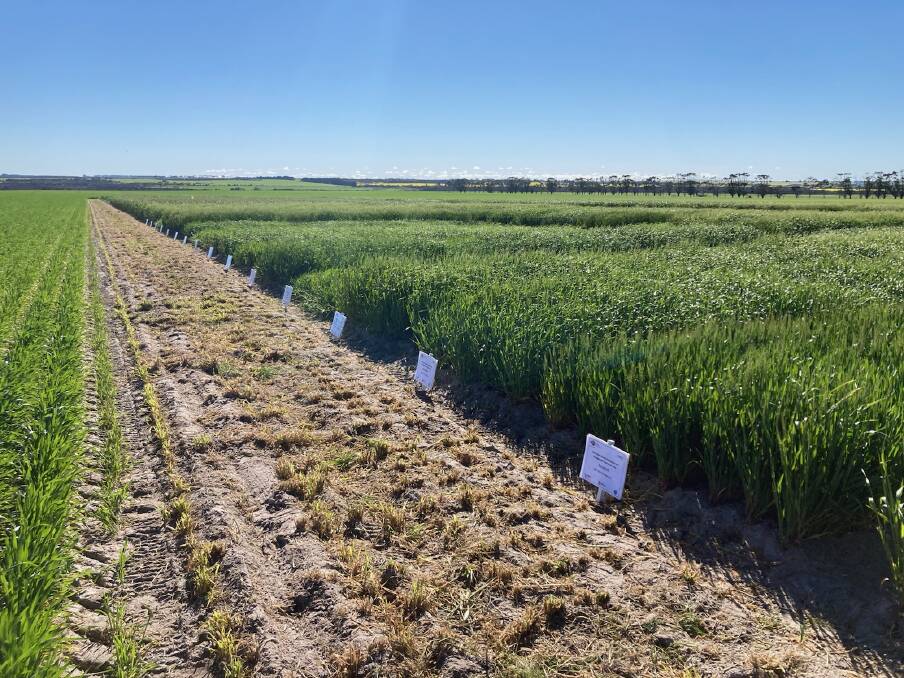
A BARLEY field trial attempting to raise the yield bar for the high rainfall zones in Western Australia, particularly on ameliorated soils, has achieved the aspirational goal of eight tonnes per hectare this season.
Subscribe now for unlimited access to all our agricultural news
across the nation
or signup to continue reading
The Grains Research and Development Corporation (GRDC) high rainfall zone farming systems project is led by the Department of Primary Industries and Regional Development (DPIRD), with the cereals component managed by Field Applied Research (FAR) Australia.
The experiments focused on developing new yield benchmarks on ameliorated soils comparing genetic, environmental and management factors that have the potential to drive yield and push productivity.
The small plot scale trial, run on the Whiting family's farm at Gibson alongside large replicated farm trials, evaluated the impact of management such as defoliation (grazing), increased nitrogen applications and more intensive fungicide strategies, as well as the effect of the actual variety.
The crop, which was the first cereal after canola, was sown on April 16 on soil that had been deep ripped to 800 millimetres and sown into a wet seed bed after the early cyclonic rainfall.
After going in under near-perfect conditions, the rain kept coming during winter and while there were some periods of mild waterlogging during the year, it had been a favourable season.
But it meant nitrogen and disease management became more important.
FAR Australia research director Kenton Porker said yield was the number one driver of profitability but it was not necessarily just about more inputs.
"It's about the timing of those inputs as well and managing the crop canopy, especially if you're going to use a more expensive fungicide, then it's critical to hold it until later in the season to keep the leaves greener," Dr Porker said.
"We are trying to protect our grain yield potential later in the season to realise high yields, as a vigorous and healthy crop early in the season does not always convert its biomass into grain yield.
"This is where the concept of canopy management is important, keeping crops in peak condition for when it matters using nitrogen, fungicide and a variety that develops at the right time for the environment."

Part of the management includes ensuring that in the 20 to 30 days prior to flowering, the crop is seeing the best part of the environment and has all its green leaves intercepting light, so it shouldn't be nitrogen deficient or water stressed during that period.
The results from the trial, which was harvested on November 3, speak for themselves and in the high input management strategy, both RGT Planet and Laperouse, which is a new barley variety that looks very promising for WA, yielded 8t/ha.
When compared to the standard input management containing a slightly less robust fungicide regime and reduced nitrogen, Laperouse was still relatively high yielding at 7.16t/ha and higher than RGT Planet, at 6.59t/ha.
That suggests Laperouse has slightly better disease resistance and maybe requires less nitrogen to achieve maximum yield.
It also highlights the importance of disease management in more susceptible high yielding cultivars like RGT Planet.
"Given the trial was sown early, the winter cultivar Urambie was used in the experiment - it flowers later and can be sown earlier, ideally suited to grain and grazing scenarios," Dr Porker said.
Despite its flowering behaviour the data shows it does not have the same yield potential as a grain only variety compared to RGT Planet and Laperouse.
"However, that variety's big advantage was that it best handled the grazing strategy, so if growers are thinking about sowing early and wanting to graze, that was the only cultivar that didn't lose yield from simulated grazing."
While efforts are underway to introduce varieties that have improved disease resistance, the data demonstrates that in wet seasons disease management using both cultivar resistance and timely fungicide applications will help growers realise higher yields.
Experiments such as these demonstrate the new yield potential boundaries growers should be targeting and what can be achieved when soil constraints are addressed, effectively increasing water availability and yield potential.
"We've managed to increase yield by 1.5t/ha in RGT Planet, simply by applying more nitrogen and a more expensive fungicide regime," Dr Porker said.
"The cost benefit of the inputs clearly does stack up and the additional spend is giving additional returns.
"Whereas in a cultivar such as Laperouse, with improved disease resistance, the return on the extra investment was 0.8t/ha in yield."
Want weekly news highlights delivered to your inbox? Sign up to the Farm Weekly newsletter.


